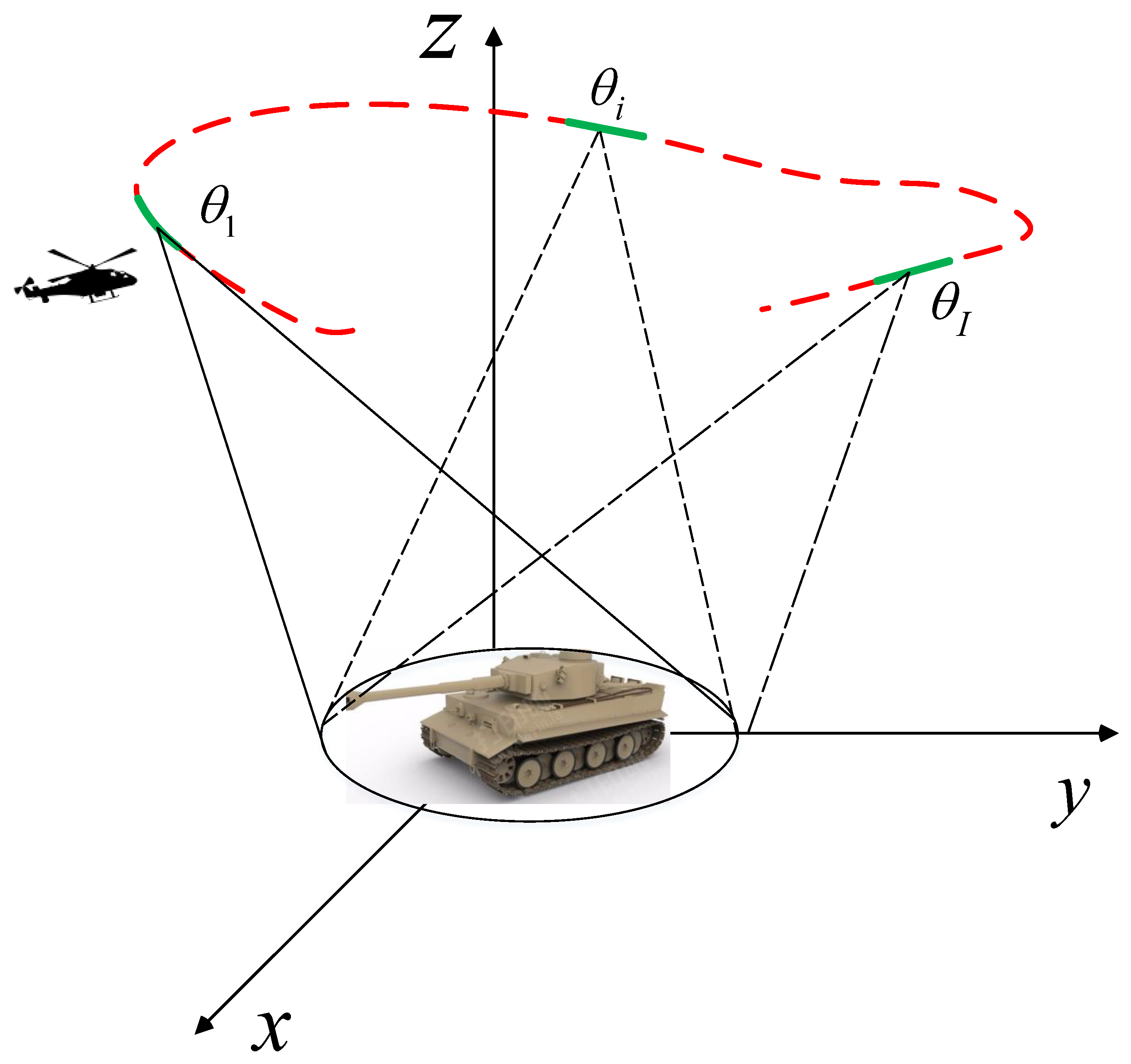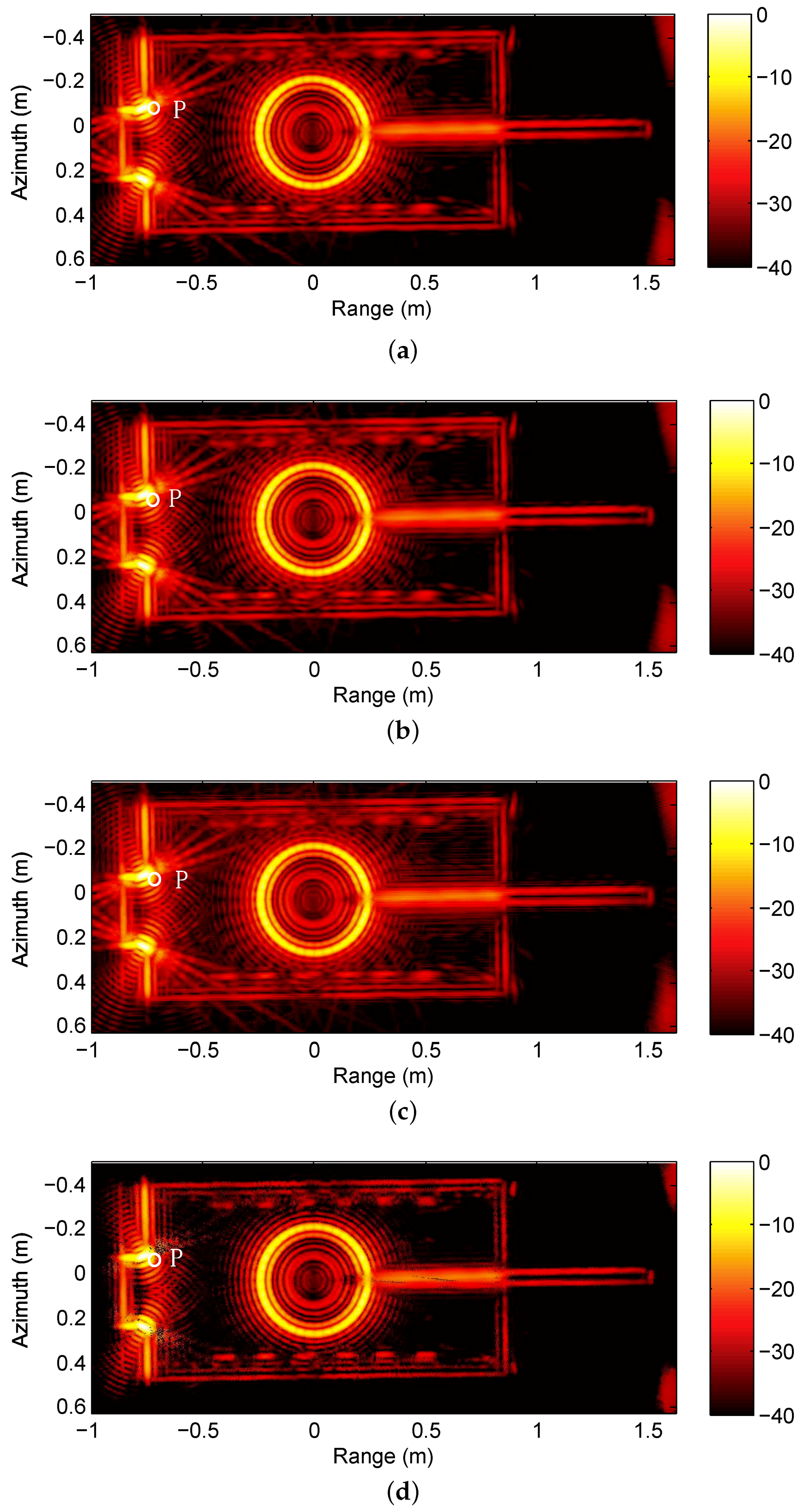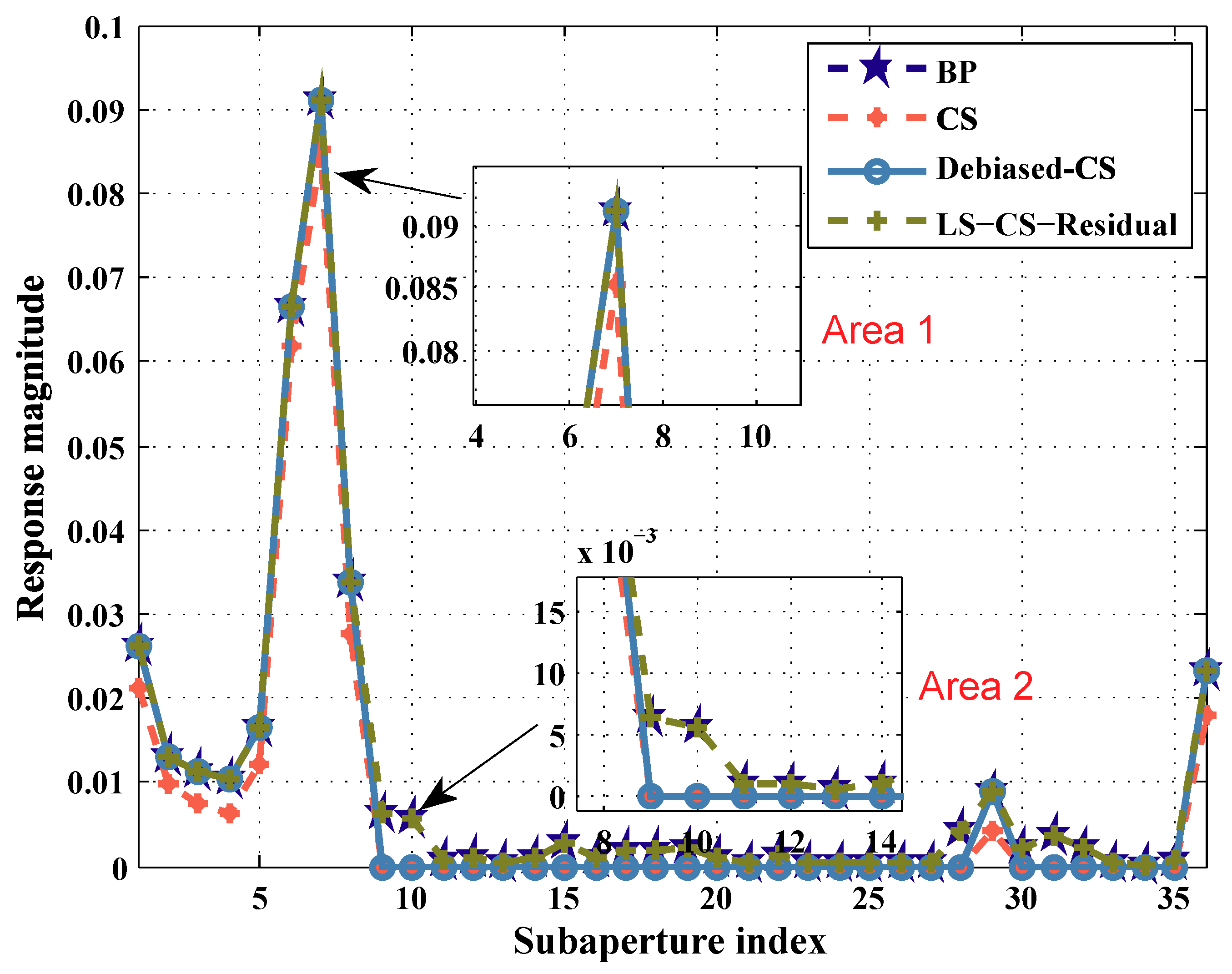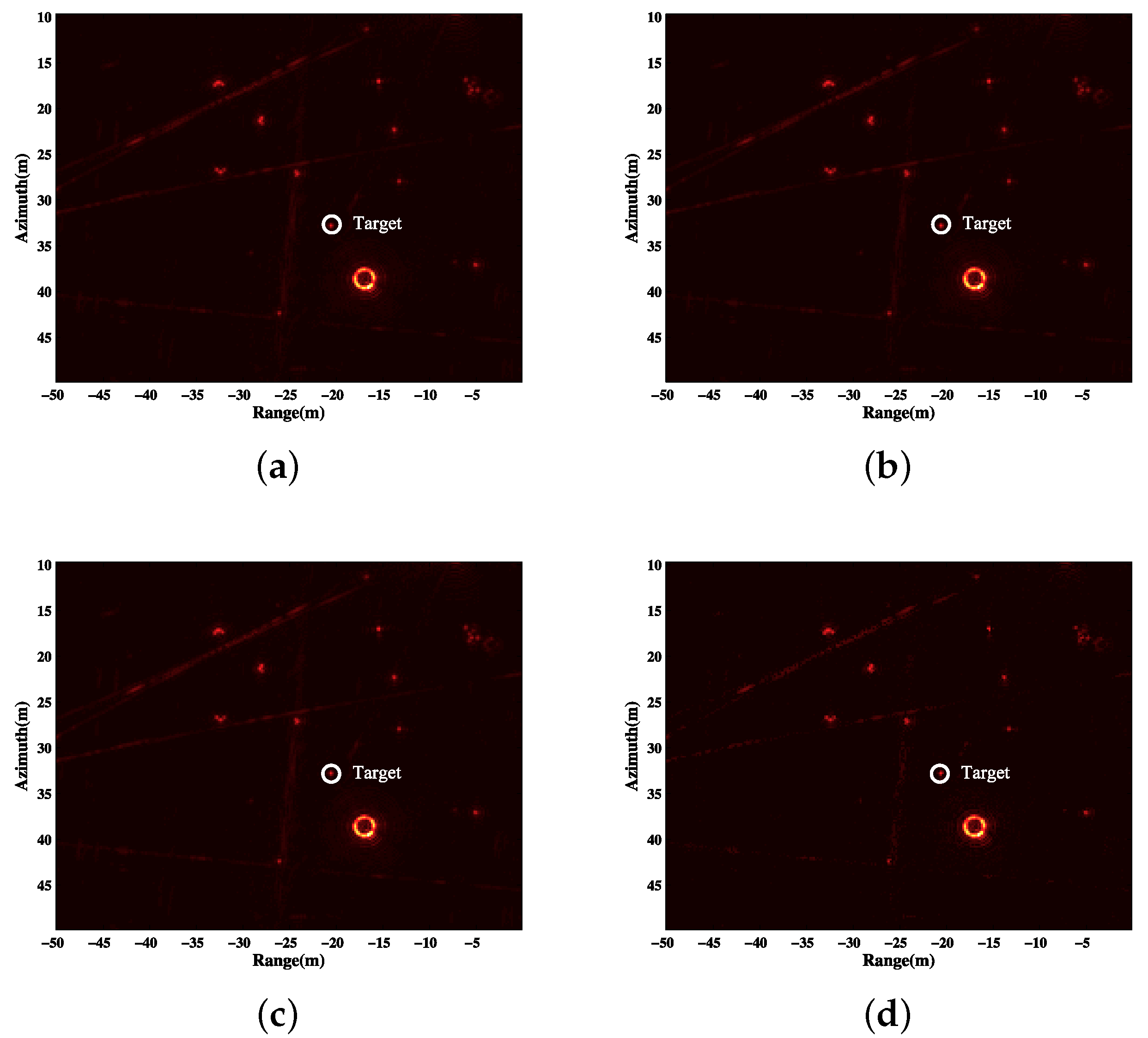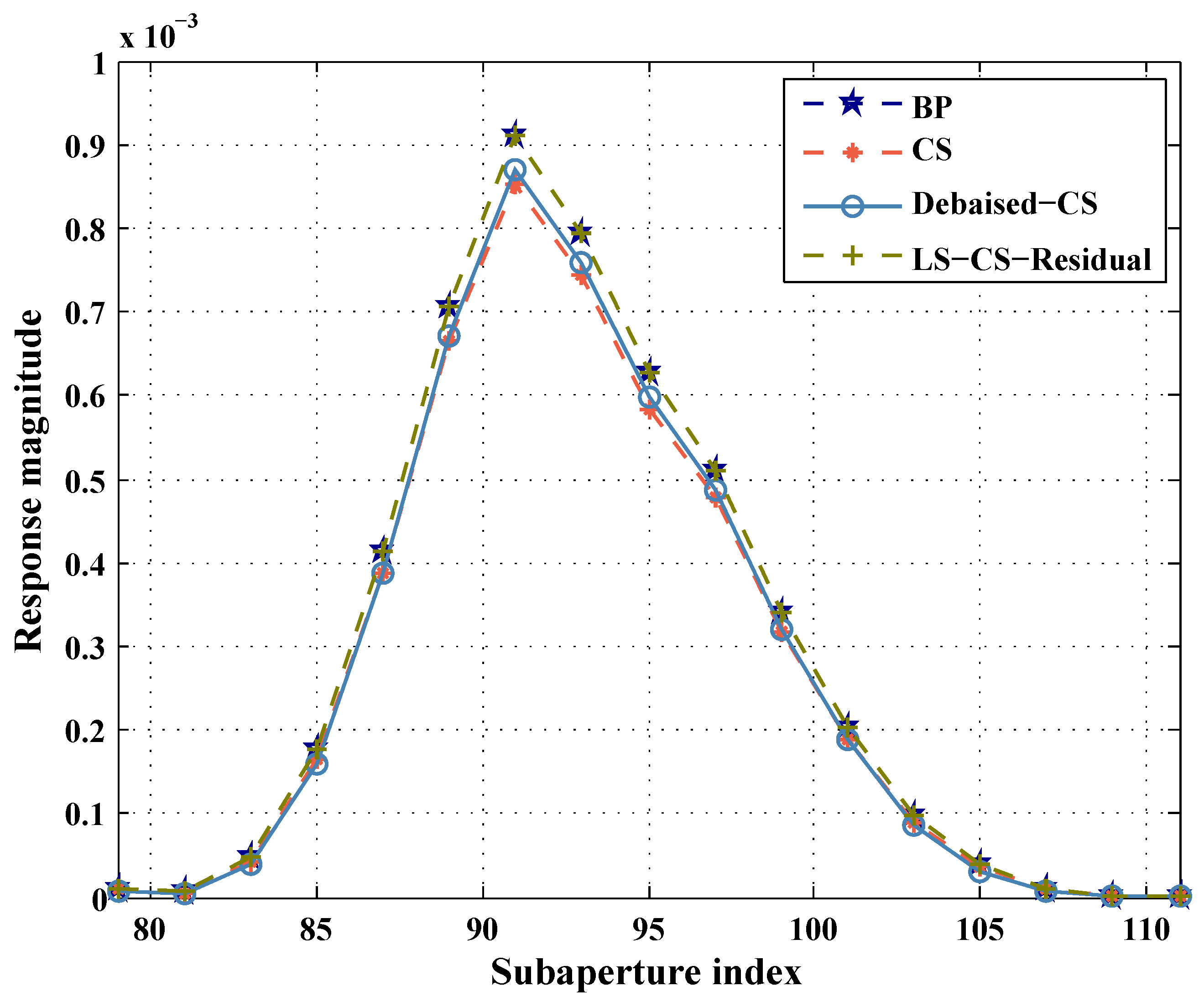1. Introduction
Wide angle synthetic aperture radar (WASAR) receives echo data from a large angle. Advances in synthetic aperture radar (SAR) technology have enabled coherent sensing of WASAR. Circular SAR (CSAR) is a specific case of WASAR whose track is circular. With the increase of the synthetic angle, because of the reflector geometry, shadowing, and coherent scintillation, the problem of aspect dependent scattering [
1,
2] arises. Traditional imaging methods are based on the isotropic assumption. It means that the scattering is constant in the synthetic aperture angle, which is not valid in WASAR.
To accommodate the aspect dependent scattering, there are mainly two approaches, the subaperture approach and full aperture approach [
2]. The subaperture approach [
1] divides the whole aperture into the subapertures and assumes that the scatterings are constant in the subaperture. Then, the narrow angle imaging methods such as matched filtering [
3] and an
regularization based SAR imaging method [
4,
5] can be adopted for the subaperture imaging. For the full aperture approach, they can be divided into two kinds. The first one assumes that the scattering during one subaperture is isotropic and reconstructs an imaging model with all subapertures included [
6,
7,
8]. The subaperture images are recovered jointly. The other one is the parametric method [
9,
10]. It assumes that the scene includes some scattering targets and that their scatterings follow some functions. The scattering functions of the targets are fitting with the whole aperture data included.
In the past decade, compressed sensing (CS) [
11,
12] has drawn much attention in sparse signal processing, which provides reconstruction guarantees for sparse solutions to linear inverse problems. It is shown that, when the scene is sparse and the measurement matrix satisfies the Restricted Isometry Property (RIP), the signal can be recovered with down-sampled data by solving an
minimization problem [
12]. An
minimization problem is also known as Basis Pursuit. The theory of Lagrange multipliers indicates that we can solve an unconstrained problem that will yield the same solution, provided that the Lagrange multipler is selected correctly. The unconstrained problem is known as LASSO or
regularization [
13]. For the subaperture reconstruction based on
regularization, it mainly has two drawbacks. Firstly, as a common reconstructed model in compressed sensing (CS),
regularization is a biased estimator [
14], which means that the amplitude of the targets would be underestimated. Secondly, the support set of the targets is not accurately estimated with the data of one subaperture and there are some missed detections. For the first drawback, it can be solved via debiased-CS proposed in [
15,
16]. Debiased-CS is a two-step method, which firstly reconstructs the signal with CS and calculates the least squares (LS) estimates on the support set of the signal. For the second drawback, since the support sets of different aspect subaperture images are highly overlapped across the whole aperture [
9], this information can be adopted in the subaperture image reconstruction to avoid it.
The idea of CS is to compressively sense signals that are sparse in some known domains and then use sparse recovery techniques to recover them. Considering the dynamic CS problem, i.e., the problem of recovering a time sequence of sparse signals, CS recovers each sparse signal in the sequence independently without using any information from other frames. Least squares on compressed sensing residual (LS-CS-Residual) [
17] is to replace CS on the observation by CS on the least squares (LS) residual computed using the prior estimate of the support. It is suitable for dynamic CS problem. It is proved that LS-CS-Residual can recover the signal better than CS [
17].
The subaperture images of WASAR can be regarded as the SAR video. Every frame is the subaperture image indexed by the aspect angle. In WASAR, the backscattering from a complex target at high frequencies can be approximately modeled as a discrete set of the scattering centers [
9].The scattering center can be described by the aspect-dependent amplitude and position [
9]. The supports of the scattering centers overlap across the whole aperture. This information can be adopted in WASAR imaging.
In this paper, we propose a novel subaperture imaging method based on LS-CS-Residual. The proposed method firstly implements Backprojection (BP) on all of the aperture data. Then, the coarse support set is estimated from the BP image. For every subaperture of WASAR, the least squares estimate on the support set is calculated. Then, the observation residual is calculated. With the residual data, we can solve the residual observation model with regularization. The accurate supports of subaperture images are estimated from the regularization image. Finally, the LS estimate on the accurate supports is calculated. Since the structure information and LS estimate on the support set are adopted in the proposed method, it can recover the aspect dependent scattering more accurately than CS and debiased-CS.
In the iteration of LS-CS-Residual, there are matrix-vector products. For large scale scenes, the storage of measurement matrix can cost a huge amount of memory. A common strategy is to adopt the azimuth-range decouple operators in the algorithm. In this paper, the BP based azimuth-range decouple operators are adopted. The memory cost is reduced from to .
This paper is organized as follows. In
Section 2, we describe the WASAR subaperture imaging model based on CS.
Section 3 introduces the WASAR imaging method based on LS-CS-Residual.
Section 4 presents the experimental results. The conclusions are presented in
Section 5.
2. WASAR Subaperture Imaging Based on Compressed Sensing
WASAR receives data from a large angle. The configuration of WASAR is depicted in
Figure 1. The whole aperture can be divided into subapertures. For the data collected from a little subaperture, its scattering can be regarded as constant. Then, the phase history of the
i-th (
) subaperture is formulated as
where
is the phase history data of the
i-th subaperture, and
m and
n are the pixel indexes along
x and
y.
M and
N are the pixel numbers along
x and
y,
s is the scattering reflectivity of the
i-th subaperture which is located at
,
is the frequency,
c is the light velocity,
is the aspect angle, and
is additive noise.
We vectorize Equation (
1) and express it in a compact form
where
is the history data of
i-th subaperture,
is the backscattering of
i-th subaperture, and
is the noise, the measurement matrix
is shown as
where
.
The subaperture imaging methods for WASAR imaging assume that the scattering of the targets are not relevant to the aspect angle in a narrow angle. Then, a traditional imaging method can be implemented in subaperture image focusing.
CS has been introduced into SAR imaging [
4]. When the scene is sparse and the measurement matrix satisfies the restricted isometry property (RIP) condition, Equation (
2) can be solved via
regularization [
18]
where
is the regularization parameter.
For Equation (
4), the optimality condition is
where
is the conjugate transpose and
Suppose the oracle support of the
is
T, and then the solution of (
4) is
where
,
denotes the complement of
T.
is the signal function formulated as
If the oracle support is accurate, then the first term of (
7) is the exact estimate of the signal. The second term of (
7) is the bias that is brought by the regularized term of (
4).
In [
14], it is shown that
can reconstruct the targets with the underestimated amplitudes. Some missed detections are also introduced in the results of
regularization. In addition, with less azimuth measurements, the resolution of the subaperture is reduced. The underestimation can be reduced via LS on the support. The missed detections can be reduced when more information is adopted. In the next section, we will propose a novel method for WASAR subaperture imaging.
3. WASAR Imaging Based on LS-CS-Residual
regularization would cause the errors of the amplitude and support set estimation in WASAR imaging. In this section, we propose a novel WASAR imaging based on LS-CS-Residual.
In WASAR, the subaperture images can be regarded as the video indexed on subaperture [
2], which is a map of reflectivity as a function of viewing angle. The reflectivities of the targets can be described via their amplitudes and positions. Although they vary with aspect angle, the positions are highly overlapped. Some methods for dynamic scene such as video signal processing and dynamic MRI imaging can be introduced to WASAR imaging.
LS-CS-Residual [
17] has been proposed for dynamic CS problems, such as dynamic magnetic resonance imaging (MRI). The idea of LS-CS-Residual is to perform CS not from the observations, but from the least squares residual computed using the previous support estimation. It is shown that it needs fewer samples and the bounded reconstruction error is smaller than the traditional CS. In the model of LS-CS-Residual, the information between different frames are used and there is also a debiasing step in the final to reduce the bias caused by
regularization. It can reconstruct the results much more accurately than CS.
Since the support sets of between different WASAR subaperture images are highly overlapped, which means that WASAR imaging can be regarded as a dynamic problem. Thus, LS-CS-Residual is suitable for WASAR subaperture imaging. In the frame of LS-CS-Residual, the LS estimate is included, which means that the underestimation of regularization is avoided. In addition, the support information of different subapertures will be used, which will make the results more accurate.
LS-CS-Residual mainly has three steps: initial LS estimation, implementing CS on the residual (CS-Residual) and final LS estimate.
Initial LS Estimate
For Equation (
2), if the support set of
is known, we could simply compute the LS estimate on the support while setting all other values to zeros. The previous support can be estimated from the prior information. Suppose the estimated support is
T, to compute and initial LS estimate
Then, the LS residual is calculated as
In WASAR, the scattering of the targets is aspect dependent. However, the support sets of the subaperture images are highly overlapped, which means that a fairly accurate support
T can be estimated from the data.
T is estimated via
which is the support of the elements whose amplitudes are larger than
.
In [
17], the threshold
is determined by the
b%-Energy support, which means that
T contains at least
of the signal energy. In WASAR imaging, we set
.
Notice that the LS residual,
, can be rewritten as
CS-Residual
In this step, CS is implemented on the LS residual, i.e., solve (
12) with CS in the following model
Iterative shrinkage thresholding algorithm (ISTA) [
19] can be used to solve (
13). In the iteration of ISTA, there are no matrix inversions involved. ISTA is preferred for its simplicity in implementation for distributed or parallel recovery due to nature of the involved matrix-vector multiplications [
20,
21]. The iteration is formulated as
where
is the step size controlling the convergence,
is the regularization parameter, and
f is the iterative function of ISTA. In the iteration, the value of
is
where
is the
-th largest element of
and
.
Final LS Estimation
It is shown that
is obtained after
regularization, and the estimation will be biased towards zeros. Thus, a debiasing step is needed
After the construction of the subaperture images, the generalized likelihood ratio test (GLRT) [
1] can be implemented for the final composite image. GLRT is defined as
where
is the scattering at pixel
of
i-th subaperture.
The algorithm is summarized in Algorithm 1.
| Algorithm 1 LS-CS-Residual based WASAR imaging. |
- Input:
Subaperture echo data and measurement matrix , iterative parameter , maxmum iterative step . - 1:
Implement BP on the whole aperture data, estimate T from the BP image. , . - 2:
fordo - 3:
- 4:
- 5:
- 6:
- 7:
while and do - 8:
- 9:
- 10:
- 11:
- 12:
- 13:
end while - 14:
- 15:
- 16:
- 17:
end for - 18:
- Output:
s(x,y)
|
In WASAR imaging, it will cost huge amount of memory to store the measurement matrix. The azimuth-range decouple operators can be used to reduce the memory cost [
5]. In this paper, we take BP based operators to substitute the measurement matrix and its conjugate transpose in real WASAR imaging. With the BP based operators, the memory cost can be reduced dramatically. If we reconstruct the measurement matrix, the memory cost is
. With the BP based operators, the memory cost is
. It means that, with the measurement matrix, the memory cost is reduced from
to
.
BP mainly includes two operations: range Fourier transform and azimuth coherent addition. The imaging and raw data generation procedures are formulated as
where
and
are the the Fourier transform pairs,
is azimuth coherent addition operator and
is its inverse operation,
reshapes the vector into matrix and
reshapes the matrix into a vector.
